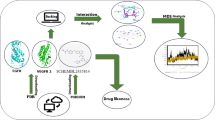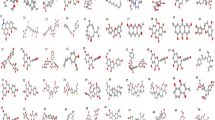Abstract
Purpose of the Study
Breast cancer is a severe malignancy responsible for significant mortality in women globally. This has attracted a wider attention of the scientific community in order to find an effective therapeutic solution by the development of novel, potent antagonistic bioavailable ligands to be used as future anticancer drugs. Mechanistic target of rapamycin (mTOR), being a protein kinase, has been implicated in variety of activities regulating cell growth, survival, metabolism, and immunity. mTOR activation has been associated with tumor growth and metastasis as well. Since chromones and flavonoids are an important class of natural products having numerous biological properties, the aim of our study was to explore these molecules for the development of a potential bioavailable inhibitor against mTOR using computer-aided drug designing (CADD).
Recent Findings
Results indicated that the best designed ligand displayed maximum binding affinity (ΔG − 4.91 kcal/mol) around the binding cleft along with lower RMSD value, exhibiting safety and efficacy features as well. Further molecular docking studies based on PEM, equilibrated NVT-NPT, radius of gyration, and RMSF revealed the stability of the complex as well.
Summary
The substrate recruiting triad of mTOR protein was targeted, for which a library of molecules was developed and after extensive screening, a final ligand molecule (lig34) was identified as the most promising candidate having enough binding energy and fits best with biosafety parameters. Ligand (lig34) was adjudged best upon the bioavailability parameters, displaying inhibitory characteristics with lower toxicity levels.


Similar content being viewed by others
References
Papers of particular interest, published recently, have been highlighted as: • Of importance •• Of major importance
• Kashyap D, Garg VK, Tuli HS, Yerer MB, Sak K, Sharma AK, et al. Fisetin and quercetin: promising flavonoids with chemopreventive potential. Biomolecules. 2019;9(5):174. https://doi.org/10.3390/biom9050174. The article deals with the promising potential of flavonoids in therapeutics.
Var Ruchi Sharma DKS, Mishra N, Sharma AK, Batra N. New and potential therapies for the treatment of Breast Cancer: an update for oncologists. Curr Trends Biotechnol Chem Res. 2016;6(1):23–9.
Obakan-Yerlikaya P, Arisan ED, Coker-Gurkan A, Palavan-Unsal N. Breast cancer and flavonoids as treatment strategy. Breast Cancer. 2017;305. https://doi.org/10.5772/66169.
• Batra P, Sharma AK. Anti-cancer potential of flavonoids: recent trends and future perspectives. 3 Biotech. 2013;3(6):439–59. https://doi.org/10.1007/s13205-013-0117-5. This article has extensively covered the promising therapeutic potential of flavonoids in cancer.
Sheikh ISV, Singh HT, Aggarwal D, Sankhyan A, Vyas P, Sharma AK, et al. Cancer chemoprevention by flavonoids, dietary polyphenols and terpenoids. Biointerface Res Appl Chem. 2020;11(1):8502–37. https://doi.org/10.1007/978-981-13-7607-8_5.
Zhang CX, Ho SC, Chen YM, Fu JH, Cheng SZ, Lin FY. Greater vegetable and fruit intake is associated with a lower risk of breast cancer among Chinese women. Int J Cancer. 2009;125(1):181–8. https://doi.org/10.1002/ijc.24358.
Ni F, Gong Y, Li L, Abdolmaleky HM, Zhou J-R. Flavonoid ampelopsin inhibits the growth and metastasis of prostate cancer in vitro and in mice. PLoS One. 2012;7(6). https://doi.org/10.1371/journal.pone.0038802.
Hui C, Yujie F, Lijia Y, Long Y, Hongxia X, Yong Z, et al. MicroRNA-34a and microRNA-21 play roles in the chemopreventive effects of 3, 6-dihydroxyflavone on 1-methyl-1-nitrosourea-induced breast carcinogenesis. Breast Cancer Res. 2012;14(3):R80. https://doi.org/10.1186/bcr3194.
Khadem S, Marles RJ. Chromone and flavonoid alkaloids: occurrence and bioactivity. Molecules. 2012;17(1):191–206. https://doi.org/10.3390/molecules17010191.
Ram GSV, Sheikh I, Sankhyan A, Aggarwal D, Sharma AK. Anti-cancer potential of natural products: recent trends, scope and relevance. Lett Appl NanoBioSci. 2020;9(1):902–7. https://doi.org/10.33263/LIANBS91.774778.
Aune D, Chan D, Vieira A, Rosenblatt DN, Vieira R, Greenwood D, et al. Fruits, vegetables and breast cancer risk: a systematic review and meta-analysis of prospective studies. Breast Cancer Res Treat. 2012;134(2):479–93. https://doi.org/10.1007/s10549-012-2118-1.
Hui C, Qi X, Qianyong Z, Xiaoli P, Jundong Z, Mantian M. Flavonoids, flavonoid subclasses and breast cancer risk: a meta-analysis of epidemiologic studies. PLoS One. 2013;8(1):e54318-e. https://doi.org/10.1371/journal.pone.0054318https://doi.org/10.1371/journal.pone.0054318.
•• Sharma V, Sharma AK, Punj V, Priya P, editors. Recent nanotechnological interventions targeting PI3K/Akt/mTOR pathway: a focus on breast cancer. Semin Cancer Biol. 2019;59(10):133–46. https://doi.org/10.1016/j.semcancer.2019.08.005This article has focussed on the recent approaches being employed to target PI3K/Akt/mTOR pathway in breast cancer leading to understand the underlying mechanism.
•• Sharma V, Kumar Gupta G, Sharma KA, Batra N, Sharma KD, Joshi A, et al. PI3K/Akt/mTOR intracellular pathway and breast cancer: factors, mechanism and regulation. Curr Pharm Des. 2017;23(11):1633–8. https://doi.org/10.2174/1381612823666161116125218. The article has led to understand the the importance of PI3K/Akt/mTOR pathway in breast cancer and variety of factors and regulations involved, so as to get insight into the underlying mechanism.
Zhang Y. I-TASSER server for protein 3D structure prediction. BMC Bioinformatics. 2008;9(1):40. https://doi.org/10.1186/1471-2105-9-40.
VarRuchi Sharma AKS. Identification and characterization of Ligands binding to key enzymes of mTOR kinase signalling pathway involved in Breast Cancer. http://hdl.handle.net/10603/256670.2019.
•• Bryliński M, Prymula K, Jurkowski W, Kochańczyk M, Stawowczyk E, Konieczny L, et al. Prediction of functional sites based on the fuzzy oil drop model. PLoS Comput Biol. 2007;3(5). https://doi.org/10.1371/journal.pcbi.0030094. The article highlights about the potential use of fuzzy oil drop model for the prediction of functional sites.
Chahar MK, Sharma N, Dobhal MP, Joshi YC. Flavonoids: a versatile source of anticancer drugs. Pharmacogn Rev. 2011;5(9):1–12. https://doi.org/10.4103/0973-7847.79093.
Amawi H, Ashby CR Jr, Tiwari AK. Cancer chemoprevention through dietary flavonoids: what’s limiting? Chin J Cancer. 2017;36(1):50. https://doi.org/10.1186/s40880-017-0217-4.
Tawfik HA, Ewies EF, El-Hamouly WS. Synthesis of chromones and their applications during the last ten years during the last ten years. IJRPC. 2014;4(4):1046–85.
Wang R, Gao Y, Lai L. LigBuilder: a multi-purpose program for structure-based drug design. Mol Model Annl. 2000;6(7-8):498–516. https://doi.org/10.1007/s0089400060498.
Morris GM, Huey R, Olson AJ. Using autodock for ligand‐receptor docking. Curr Protoc Bioinformatics. 2008;24(1):8.14.1–8. https://doi.org/10.1002/0471250953.bi0814s24.
Nogara PA, Saraiva RA, Caeran Bueno D, Lissner LJ, Lenz Dalla Corte C, Braga MM, et al. Virtual screening of acetylcholinesterase inhibitors using the Lipinski’s rule of five and ZINC databank. Biomed Res Int. 2015. https://doi.org/10.1155/2015/870389.
DeLano WL. PyMOL. 2002.
• Sharma VRBN, Sharma AK. In-Silico designed and optimized lead inhibiting breast cancer mtor frb domain substrate recruitment mechanism. IPO. 2020. This invention has led to the designing of an antogonistic molecule which could inhibit the mTOR FRB Domain,thus having therapeutic implications in breast cancer.
Jarrahpour A, Fathi J, Mimouni M, Hadda TB, Sheikh J, Chohan Z, et al. Petra, Osiris and Molinspiration (POM) together as a successful support in drug design: antibacterial activity and biopharmaceutical characterization of some azo Schiff bases. Med Chem Res. 2012;21(8):1984–90. https://doi.org/10.1007/s00044-011-9723-0.
Berendsen HJ, van der Spoel D, van Drunen R. GROMACS: a message-passing parallel molecular dynamics implementation. Comput Phys Commun. 1995;91(1-3):43–56.
Schüttelkopf AW, Van Aalten DM. PRODRG: a tool for high-throughput crystallography of protein–ligand complexes. Acta Crystallogr D Biol Crystallogr. 2004;60(8):1355–63. https://doi.org/10.1107/S0907444904011679.
Bayle JH, Grimley JS, Stankunas K, Gestwicki JE, Wandless TJ, Crabtree GR. Rapamycin analogs with differential binding specificity permit orthogonal control of protein activity. Chem Biol. 2006;13(1):99–107. https://doi.org/10.1016/j.chembiol.2005.10.017.
Gulati N, Karsy M, Albert L, Murali R, Jhanwar-Uniyal M. Involvement of mTORC1 and mTORC2 in regulation of glioblastoma multiforme growth and motility. Int J Oncol. 2009;35(4):731–40. https://doi.org/10.3892/ijo_00000386.
• Zhu W, Sun C, Xu S, Wu C, Wu J, Xu M, et al. Design, synthesis, anticancer activity and docking studies of novel 4-morpholino-7,8-dihydro-5H-thiopyrano[4,3-d]pyrimidine derivatives as mTOR inhibitors. Bioorg Med Chem. 2014;22(24):6746–54. https://doi.org/10.1016/j.bmc.2014.11.003. This article deals with designing,synthesis and anticancer potential of novel 4-morpholino-7,8-dihydro-5H-thiopyrano[4,3-d]pyrimidine derivatives targeting mTOR.
• Gunn RM, Hailes HC. Insights into the PI3-K-PKB-mTOR signalling pathway from small molecules. J Chem Biol. 2008;1(1-4):49–62. https://doi.org/10.1007/s12154-008-0008-0. This article puts forth the pivotal role of small molecules to get insight into the PI3-K-PKB-mTOR signalling pathway.
Acknowledgments
We greatly acknowledge Maharishi Markandeshwar (Deemed to be University) Mullana (Ambala) Haryana, India for providing the requisite platform to carry out this work.
Author information
Authors and Affiliations
Corresponding author
Ethics declarations
Authors are committed to and follow strictly the publication ethics.
Conflict of Interest
Certified that there is no conflict of interest pertaining to publication of this manuscript in your esteemed journal.
Human and Animal Rights and Informed Consent
This article does not contain any studies with human or animal subjects performed by any of the authors.
Additional information
Publisher’s Note
Springer Nature remains neutral with regard to jurisdictional claims in published maps and institutional affiliations.
This article is part of the Topical Collection on Natural Products: From Chemistry to Pharmacology
Rights and permissions
About this article
Cite this article
Sharma, V., Panwar, A. & Sharma, A.K. Molecular Dynamic Simulation Study on Chromones and Flavonoids for the In Silico Designing of a Potential Ligand Inhibiting mTOR Pathway in Breast Cancer. Curr Pharmacol Rep 6, 373–379 (2020). https://doi.org/10.1007/s40495-020-00246-1
Accepted:
Published:
Issue Date:
DOI: https://doi.org/10.1007/s40495-020-00246-1




